Abstract
Intercropping has been widely proven to boost agricultural yields and control diseases. This study examined the impact of sugarcane monoculture (SM) and sugarcane–pumpkin intercropping (IP) systems on soil physicochemical characteristics and microbial community dynamics. Compared to monoculture, intercropping significantly increased soil pH by 8.82% and total potassium (TK) by 17.92%, while reducing soil organic matter (SOM) by 25.56%. Bacterial communities under intercropping exhibited significantly higher alpha and beta diversity, whereas fungal community diversity remained unaffected. Notably, the relative abundances of certain taxa with known roles in plant growth promotion and pathogen suppression—such as Anaeromyxobacter, Nitrospira, and Massilia—were enriched. Canonical correlation analysis revealed that bacterial community composition was strongly associated with TK, while fungal community structure correlated with variations in soil available nitrogen (AN). These findings indicate that sugarcane–pumpkin intercropping reshapes soil microbial communities and contributes to some improvement in soil nutrient availability.
1. Introduction
Intercropping, the practice of cultivating multiple crops on the same land, enhances the utilization of environmental resources and improves biomass conversion efficiency [1]. Previous research has demonstrated that intercropping can alter rhizosphere microbial communities and soil physicochemical properties. For example, sugarcane–peanut intercropping modifies microbial abundance and enzyme activity, thereby regulating genes involved in nitrogen and phosphorus cycling as well as organic matter turnover [2]. Similarly, potato–onion intercropping has been shown to increase the alpha and beta diversity of both bacterial and fungal communities, along with bacterial abundance [3]. Moreover, increased microbial diversity under intercropping can enhance the nutrient uptake efficiency and mitigate the impact of soil-borne pathogens [4].
Sugarcane (Saccharum officinarum L.), a key global sugar crop, plays a vital role in agricultural economies and sugar supply chains worldwide [5,6]. Accounting for approximately 80% of global sugar production, sugarcane also serves as an essential raw material for animal feed, paper production, and ethanol manufacturing [7]. Its wide row spacing and extended growing period make it particularly suitable for intercropping with low-growing, short-season crops [8]. Pumpkin (Cucurbita moschata) is a commonly cultivated trailing plant with global distribution [9,10]. Pumpkins grow during the early to mid-growth stages of sugarcane, effectively utilizing sunlight and land resources that would otherwise remain idle in sugarcane fields during this early phase. Furthermore, sugarcane is deep-rooted while pumpkins are shallow-rooted. Intercropping pumpkins with sugarcane allows for efficient utilization of nutrients in the topsoil layer and minimizes competition for nutrients with the sugarcane [11,12].
Although various sugarcane intercropping systems have been studied, most have focused on legumes [13,14], while the effects of sugarcane–pumpkin intercropping on rhizosphere soil fertility and microecological conditions remain largely unexplored. To address this gap, field experiments were conducted with two treatments: sugarcane monoculture and sugarcane–pumpkin intercropping. Soil microbial community abundance and composition were assessed using quantitative PCR (qPCR) and Illumina sequencing. The study hypothesized that: (1) intercropping would improve soil quality relative to monoculture; (2) microbial diversity and abundance would be higher under intercropping than monoculture; and (3) intercropping could enhance plant growth and increase the abundance of certain microbes with the potential to suppress pathogen growth.
2. Materials and Methods
2.1. Field Plots and Experimental Design
The field experiment was conducted at Shajing Farm (22°48′ N, 108°12′ E) in Jiangnan District, Nanning City, Guangxi Province, China. The region experiences a subtropical monsoon climate, with mean annual temperature and precipitation recorded at 21.8 °C and 1286 mm, respectively. The soil type was sandy, with baseline fertility parameters as follows: available nitrogen at (AN) 68.74 mg kg−1, available phosphorus at (AP) 23.45 mg kg−1, available potassium at (AK) 70.13 mg kg−1, organic matter at 16.09 g kg−1, and a pH of 6.5.
The study utilized the sugarcane (Saccharum officinarum L.) cultivar ‘Zhongzhe 9′ and pumpkin (Cucurbita moschata) cultivar ‘Xiyang’. Two cropping systems were established: sugarcane monoculture and sugarcane–pumpkin intercropping. A randomized complete block design was implemented with three replicates per treatment, resulting in six plots (each measuring 6.0 m × 6.0 m). In both systems, five rows of sugarcane were planted with a row spacing of 1.3 m and an intra-row spacing of 0.1 m. In the intercropping treatment, pumpkins were interplanted between sugarcane rows spaced 1.5 m apart. The sugarcane was planted in early February 2024, and the pumpkin seedlings were transplanted in early March.
2.2. Soil Sampling
On 20 June 2024, rhizosphere soil samples were collected by randomly selecting nine sugarcane plants per treatment. The sugarcane plants were uprooted and gently shaken to dislodge loosely adhered soil for physicochemical analysis. Subsequently, the rhizosphere soil tightly attached to the roots was scraped off using sterile brushes into aseptic bags for soil microbial community studies. Every three plants were pooled to form one biological replicate, yielding three replicates per treatment. Each composite sample was divided into two portions: one part was flash-frozen in liquid nitrogen, transported to the laboratory, and stored at −80 °C for DNA extraction; the other was air-dried, sieved through a 2 mm mesh, and used for physicochemical analyses.
2.3. Measurement of Soil Properties
Soil properties were analyzed following standardized protocols [15]. Soil pH was measured potentiometrically in a 1:2.5 soil-to-water suspension. AN was quantified via the alkali-hydrolyzable diffusion method, while AP was extracted using sodium bicarbonate and analyzed by molybdenum–antimony colorimetry. AK was extracted with ammonium acetate and measured by flame photometry. Total potassium (TK) was measured using NaOH fusion coupled with flame photometry. Soil organic matter (SOM) content was measured by potassium dichromate oxidation with external heating.
2.4. Soil DNA Extraction, Amplification, and Sequencing
DNA was extracted from 0.25 g of fresh soil using the TIANamp Soil DNA Kit (Tiangen Biotech Co., Ltd., Beijing, China) following the manufacturer’s protocol. DNA integrity was assessed via 1% agarose gel electrophoresis, and concentrations were quantified using a UV spectrophotometer. The V3–V4 region of the bacterial 16S rRNA gene was amplified with primers 341F (5′-CCTAYGGGRBGCASCAG-3′) and 806R (5′-GGACTACNNGGGTATCTAAT-3′) [16], while the fungal ITS1-5F region was targeted using primers ITS5F (5′-GGAAGTAAAAGTCGTAACAAGG-3′) and ITS1R (5′-GCTGCGTTCTTCATCGATGC-3′) [17]. Each PCR reaction was conducted in a 15 µL volume containing Phusion High-Fidelity PCR Master Mix (New England Biolabs), 0.2 µM of each primer, and approximately 10 ng of template DNA. The thermal profile consisted of initial denaturation at 98 °C for 1 min, followed by 30 cycles of 98 °C for 10 s, 50 °C for 30 s, and 72 °C for 30 s, with a final extension at 72 °C for 5 min. Three technical replicates were performed per sample, with sterile water serving as a negative control to monitor potential contamination. PCR products were purified using magnetic bead-based methods and pooled in equimolar concentrations. After thorough mixing, target bands were detected, recovered, and used to construct sequencing libraries with index barcodes. Library quality was verified using Qubit fluorometry, real-time PCR, and bioanalyzer-based fragment analysis. Libraries were then pooled and sequenced on Illumina platforms based on library concentration and target data yield.
2.5. Sequencing Data Analysis
Paired-end reads were demultiplexed using unique barcode sequences and trimmed to remove barcode and primer regions. Merging of paired-end reads was performed using FLASH (v1.2.11; http://ccb.jhu.edu/software/FLASH/) (accessed on 20 July 2024), and optimized for overlapping reads from opposite ends of the same DNA fragment to generate raw tags [18]. Quality filtering of raw tags was conducted using fastp (v0.23.1) to obtain high-quality clean tags [19]. Tag sequences were aligned against reference databases—SILVA (16S/18S; https://www.arb-silva.de/) (accessed on 11 August 2024) and UNITE (ITS; https://unite.ut.ee/) (accessed on 11 August 2024)—to identify chimeric sequences. Chimera removal was performed using the VSEARCH package (v2.16.0; https://github.com/torognes/vsearch) (accessed on 16 August 2024), resulting in a set of high-quality effective tags [20].
Subsequent denoising and feature table generation were carried out with the DADA2 pipeline implemented in QIIME2, producing high-resolution amplicon sequence variants (ASVs) [21]. Taxonomic assignment of ASVs was conducted using the SILVA database (release 138.1) for bacterial sequences and the UNITE database (v9.0) for fungal sequences via the classify-sklearn algorithm in QIIME2 (v2022.2) [22,23].
2.6. Statistical Analysis
Alpha diversity indices of soil microbial communities were calculated using QIIME2. Soil physicochemical parameters, microbial alpha and beta diversity indices, and the relative abundances of bacterial and fungal taxa at the phylum and genus levels between monoculture and intercropping treatments were compared using Student’s t-test. Statistical analyses were conducted with SPSS (Version 27.0, Armonk, NY, USA). Venn diagrams were generated using the VennDiagram package in R (Version.3.2.0, Vienna, Austria). Non-metric multidimensional scaling (NMDS) analysis was performed in R with the ade4 and ggplot2 packages. Beta diversity was assessed based on taxonomic and phylogenetic metrics using weighted UniFrac distances. Linear discriminant analysis effect size (LEfSe) was employed to identify high-dimensional biomarkers differentiating the two treatments, applying a logarithmic LDA score threshold of 3.0 for discriminative features. Canonical correspondence analysis (CCA) and related visualizations were completed in R.
3. Results
3.1. Soil Physicochemical Properties
The soil physicochemical properties under the monoculture and intercropping systems are presented in Table 1. Compared to the sugarcane monoculture, the intercropping system significantly elevated soil pH and TK content, while substantially reducing SOM levels (p < 0.05). No significant differences were detected in AN, AP, or AK between the two treatments (p > 0.05).

Table 1.
Soil physicochemical properties under sugarcane monoculture (SM) and intercropping pumpkin (IP).
3.2. Amplicon Sequencing Data and Shared OTUs
A total of 639,903 bacterial 16S rRNA and 671,633 fungal ITS sequences were obtained from six soil samples representing monoculture and intercropping systems. Following quality control procedures—including filtering, alignment, pre-clustering, and removal of chimeras and singletons—530,468 high-quality 16S rRNA sequences and 617,440 ITS sequences were retained.
Venn diagram analysis identified 12,205 bacterial and 3177 fungal ASVs across all samples (Figure 1). Among these, 2345 bacterial ASVs and 449 fungal ASVs were shared between the two cropping systems.
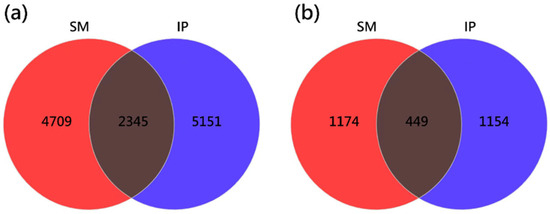
Figure 1.
Venn plot of bacterial (a) and fungal (b) OTU quantity in soil samples. SM: sugarcane monoculture; IP: intercropping pumpkin.
3.3. Soil Microbial Community Diversities and Structures
The intercropping system significantly increased both bacterial ASV richness and Shannon diversity compared to the monoculture (p < 0.05; Figure 2a), whereas fungal ASV richness and diversity showed no statistically significant differences between treatments (p > 0.05; Figure 2b).
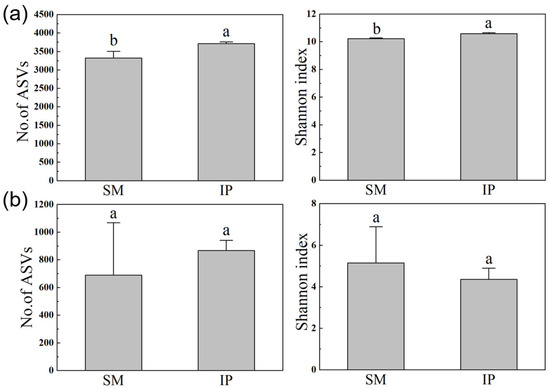
Figure 2.
Amplicon Sequence Variant (ASV) richness and Shannon diversity index of bacterial (a) and fungal (b) communities under sugarcane monoculture (SM) and pumpkin intercropping (IP). Error bars indicate standard errors. Different letters denote significant differences (p < 0.05; Student’s t-test).
The NMDS analysis showed that the stress values of bacterial and fungal communities were both 0.00 (Figure 3a,b), indicating that NMDS can accurately reflect the degree of variation between groups. The NMDS plots showed a distinct separation of bacterial communities between monoculture and intercropping treatments (Figure 3a), while fungal communities exhibited partial overlap (Figure 3b). Beta diversity analysis based on weighted UniFrac distances confirmed that intercropping significantly altered the structure of soil bacterial communities (p < 0.05; Figure 3c), whereas no significant differences were observed in fungal communities (p > 0.05; Figure 3d).
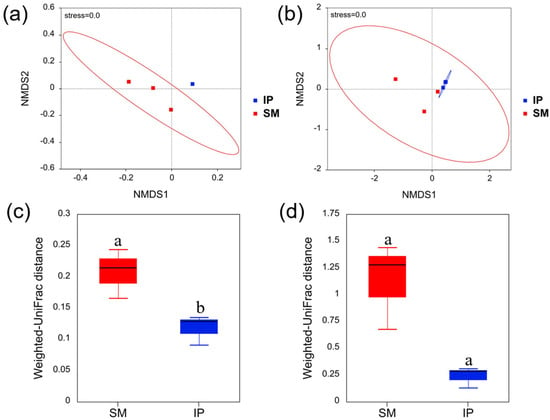
Figure 3.
Beta diversity of bacterial (a,c) and fungal (b,d) communities under sugarcane monoculture (SM) and pumpkin intercropping (IP) based on weighted UniFrac distances. Different letters indicate significant differences (p < 0.05; Student’s t-test).
3.4. Soil Bacterial Community Composition
A total of 47 bacterial phyla were identified across all soil samples. The predominant phyla in both cropping systems included Proteobacteria (25.31–32.20%), Chloroflexi (11.51–15.74%), Actinobacteriota (7.71–16.22%), Gemmatimonadota (11.94–12.72%), Acidobacteriota (10.95–11.50%), Bacteroidota (2.77–4.91%), Myxococcota (4.25–7.52%), and Verrucomicrobiota (2.16–2.96%). Collectively, these phyla accounted for 76.82% and 79.61% of the total bacterial sequences in the monoculture and intercropping systems, respectively (Figure 4a). Relative to monoculture, the intercropping system exhibited significantly higher abundances of Latescibacterota and Nitrospirota and a lower abundance of Actinobacteriota (p < 0.05). Notably, Nitrospirota, a key participant in nitrification and nitrogen cycling, was enriched under intercropping. It rapidly oxidizes toxic nitrite from ammonia-oxidizing bacteria to nitrate, potentially enhancing plant nutrient acquisition [24].
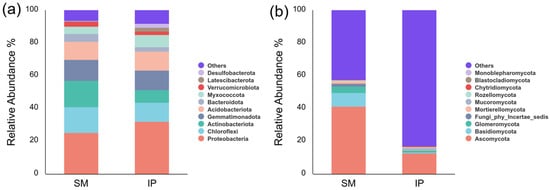
Figure 4.
Relative abundances of dominant bacterial (a) and fungal (b) phyla in soil. SM: sugarcane monoculture; IP: pumpkin intercropping.
At the genus level, 621 bacterial genera were detected. Linear discriminant analysis (LDA) revealed that genera such as Anaeromyxobacter, Ramlibacter, Ellin6067, and Nitrospira were significantly more abundant in the intercropping system, whereas Streptomyces, Haliangium, Stenotrophomonas, and Dactylosporangium were more prevalent in monoculture (Figure 5a).
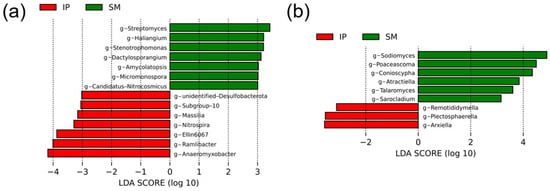
Figure 5.
Linear discriminant analysis (LDA) score histograms for differentially abundant bacterial (a) and fungal (b) genera between sugarcane monoculture (SM) and pumpkin intercropping (IP). A logarithmic LDA score threshold of 3.0 was applied to identify discriminative taxa.
3.5. Soil Fungal Community Composition
A total of 14 fungal phyla were identified across all soil samples. The dominant phyla included Ascomycota (12.81–41.32%), Basidiomycota (0.54–8.41%), Glomeromycota (1.08–3.95%), Fungi_phy_Incertae_sedis (0.29–1.59%), Mortierellomycota (0.23–1.46%), and Mucoromycota (0.07–1.23%). These phyla collectively accounted for 56.81% and 16.19% of the total fungal sequences in the monoculture and intercropping systems, respectively (Figure 4b). The relative abundance of Basidiomycota was significantly lower in the intercropping system compared to the monoculture (p < 0.05).
At the genus level, 340 fungal genera were identified. LDA revealed that Sodiomyces, Poaceascoma, Conioscypha, Atractiella, Talaromyces, and Sarocladium were significantly enriched in the monoculture system, whereas Rematididymella, Piectosphaerella, and Arxiella were more abundant in the intercropping system (Figure 5b).
3.6. Relationships Between Soil Microbial Communities and Soil Physiochemical Properties
Canonical correlation analysis (CCA) was used to explore associations between soil physicochemical properties and microbial community structures (Figure 6). For bacterial communities, CCA1 and CCA2 explained 54.96% and 28.54% of the total variance, respectively. TK was significantly correlated with bacterial community composition (r = 0.889, p = 0.04). For fungal communities, the first two CCA axes explained 41.94% and 34.70% of the total variance, with AN showing a strong positive correlation (r = 0.898, p = 0.007). Taxon–environment correlations revealed that Proteobacteria, Latescibacterota, Myxococcota, and Desulfobacterota were positively associated with soil pH and TK, while Actinobacteriota showed negative correlations with these variables but was positively associated with SOM. Additionally, Bacteroidota showed a positive correlation with AN (Figure 6a). Among fungal taxa, Blastocladiomycota, Mucoromycota, and Fungi_phy_Incertae_sedis were positively associated with AP, whereas Ascomycota showed a negative correlation. Additionally, Basidiomycota correlated positively with AN, and Chytridiomycota with soil pH (Figure 6b).
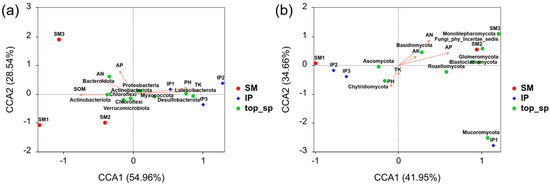
Figure 6.
Canonical correlation analysis (CCA) illustrating the relationships between environmental variables and bacterial (a) and fungal (b) communities under sugarcane monoculture (SM) and pumpkin intercropping (IP) systems.
4. Discussion
Intercropping systems enhance field biodiversity, thereby influencing soil environmental conditions [25]. Several studies have reported that intercropping can increase soil pH3, which aligns with the present findings. Additionally, the sugarcane–pumpkin intercropping system significantly elevated soil TK levels compared to the sugarcane monoculture, consistent with prior research [26,27]. TK is a key indicator of soil fertility, playing a critical role in supporting plant growth and maintaining soil health [28]. Conversely, the intercropping system resulted in a significant reduction in SOM content relative to the monoculture, a finding that contradicts the majority of the existing literature [29,30,31], although a few studies have also observed SOM declines under intercropping conditions [32,33]. This reduction may be attributed to shifts in the microbial populations associated with organic matter decomposition. Furthermore, the decrease in soil organic matter (SOM) content may also be linked to soil nitrogen levels. In the intercropping system, pumpkin’s competition for nitrogen likely triggered enhanced microbial mineralization to accelerate organic matter decomposition, enabling microbes to acquire sufficient nitrogen [34,35]. Lower SOM content can compromise soil aggregate stability, deteriorate soil structure, and impede nutrient cycling processes [36]. Furthermore, soil acidification is known to reduce fertility and restrict root development [37]. Taken together, these findings suggest that sugarcane–pumpkin intercropping improved specific soil quality parameters, thereby partially supporting the first hypothesis.
Soil microbial diversity plays a pivotal role in ecosystem functioning and is essential for sustainable agricultural systems [38,39]. In this study, both alpha and beta diversity indices of bacterial communities were significantly higher under intercropping compared to monoculture, whereas fungal communities exhibited no significant differences (Figure 2 and Figure 3). These results provide only partial support for the second hypothesis. The observed bacterial diversity patterns are consistent with previous studies [3,40,41]. The absence of significant changes in fungal diversity may be due to the inherently longer life cycles of fungi, which could limit the detection of successional changes within the short duration of this study (less than one year) [42,43]. Moreover, the increase in soil pH associated with intercropping may have suppressed the growth of specific fungal taxa sensitive to alkaline conditions [44]. The lack of treatment effects on fungal diversity may also be attributed to either insufficient statistical power in the fungal dataset or amplification bias associated with the ITS primers used [45,46].
Significant shifts in the composition of soil microbial taxa were observed between monoculture and intercropping systems (Figure 4). Notably, the relative abundance of Actinobacteriota decreased under intercropping. As a dominant phylum in soil bacterial communities, Actinobacteriota plays a pivotal role in the decomposition of organic matter and nutrient cycling [47,48]. Additionally, antibiotics produced by Actinobacteriota can influence microbial community dynamics by suppressing the growth of other soil microorganisms [49]. The intercropping system exhibited elevated relative abundances of Latescibacterota and Nitrospirota compared to the monoculture. The increase in Nitrospirota, known for its involvement in nitrification and nitrogen cycling, may enhance plant growth [50]. In contrast, the ecological functions of Latescibacterota remain poorly characterized and warrant further investigation. Within the fungal community, the relative abundance of Basidiomycota was significantly reduced in the intercropping system. Basidiomycota are key decomposers of complex organic compounds such as lignin and cellulose, contributing substantially to organic matter turnover [51,52]. The reduced abundances of Actinobacteriota and Basidiomycota under intercropping likely contributed to the significantly lower SOM content compared to the monoculture. This interpretation is further supported by LefSe analysis (Figure 5), which showed that genera associated with organic matter decomposition—such as Streptomyces, Haliangium, Dactylosporangium, Amycolatopsis, Talaromyces, and Micromonospora—were enriched in the monoculture system [53,54,55], aligning with the higher SOM levels observed. In contrast, microbial taxa associated with nutrient cycling and plant growth promotion—including Anaeromyxobacter, Nitrospira, and Massilia—were enriched under intercropping [56,57,58]. Notably, Massilia has been linked to the suppression of soil-borne pathogens [59,60]. In summary, the shifts in microbial communities within the intercropping system likely contributed to the observed reduction in SOM. However, the intercropping system also exhibited an enrichment of microbial taxa with potential plant growth-promoting and pathogen-suppressing functions. These findings align with our third hypothesis.
Analysis by CCA identified TK as the primary factor driving variation in bacterial community structure, consistent with previous studies [61,62]. Soil potassium content has been correlated with enhanced plant resistance [63], and a significant association between TK levels and Actinobacteria abundance, as observed by Wan, was also confirmed in this study [64]. The structure of fungal communities was primarily influenced by AN, in agreement with findings reported by Jiang [65].
5. Conclusions
In conclusion, the sugarcane–pumpkin intercropping system regulated key soil physicochemical parameters, specifically pH, TK, and SOM. This cropping pattern enhanced both the alpha and beta diversity of the bacterial community, but had less pronounced effects on fungal communities. Furthermore, the intercropping system facilitated the proliferation of specific bacterial and fungal taxa potentially involved in promoting plant growth and suppressing soil-borne pathogens. Microbial community composition was closely associated with soil properties, with bacterial and fungal assemblages primarily influenced by TK and AN, respectively. The four-month duration of this experiment is relatively short, which likely limits the interpretation of microbial stability or long-term community dynamics. Long-term or multi-seasonal investigations are necessary to evaluate the sustainability impacts of intercropping on microbial succession and soil resilience. We also recommend incorporating functional gene analysis in future studies to further elucidate the functional roles of soil microbial communities.
Author Contributions
X.C.: Writing—review and editing, writing—original draft, methodology, investigation, and data curation. Z.C. (Zhikui Cheng): Investigation and data curation. L.S.: Investigation and data curation. X.H.: Investigation and data curation. Y.D.: Investigation and data curation. W.B.: Investigation and data curation. Z.C. (Zhihao Chen): Investigation and data curation. B.C.: Methodology. P.W.: Validation and methodology. H.P.: Methodology and funding acquisition. Z.L.: Writing—review and editing, resources, and funding acquisition. All authors have read and agreed to the published version of the manuscript.
Funding
This research was supported by Guangxi Science and Technology Major Project (Guike AA22117008-3) (to Z.L.) and Shijiazhuang University Doctoral Scientific Research Staring Foundation (23BS023) (to H.P.).
Institutional Review Board Statement
Not applicable.
Informed Consent Statement
Not applicable.
Data Availability Statement
Data will be made available on request.
Conflicts of Interest
The authors declare no conflicts of interest.
References
- Reinprecht, Y.; Schram, L.; Smith, T.H.; Pauls, K.P. Enhancing In-Crop Diversity in Common Bean by Planting Cultivar Mixtures and Its Effect on Productivity. Front. Sustain. Food Syst. 2020, 4, 126. [Google Scholar] [CrossRef]
- Tang, X.; Zhang, Y.; Jiang, J.; Meng, X.; Huang, Z.; Wu, H.; He, L.; Xiong, F.; Liu, J.; Zhong, R.; et al. Sugarcane/Peanut Intercropping System Improves Physicochemical Properties by Changing N and P Cycling and Organic Matter Turnover in Root Zone Soil. PeerJ 2021, 9, e10880. [Google Scholar] [CrossRef] [PubMed]
- Li, N.; Gao, D.; Zhou, X.; Chen, S.; Li, C.; Wu, F. Intercropping with Potato-Onion Enhanced the Soil Microbial Diversity of Tomato. Microorganisms 2020, 8, 834. [Google Scholar] [CrossRef] [PubMed]
- Bybee-Finley, K.A.; Ryan, M.R. Advancing Intercropping Research and Practices in Industrialized Agricultural Landscapes. Agriculture 2018, 8, 80. [Google Scholar] [CrossRef]
- Apriasti, R.; Widyaningrum, S.; Hidayati, W.N.; Sawitri, W.D.; Darsono, N.; Hase, T.; Sugiharto, B. Full Sequence of the Coat Protein Gene Is Required for the Induction of Pathogen-Derived Resistance against Sugarcane Mosaic Virus in Transgenic Sugarcane. Mol. Biol. Rep. 2018, 45, 2749–2758. [Google Scholar] [CrossRef] [PubMed]
- Waclawovsky, A.J.; Sato, P.M.; Lembke, C.G.; Moore, P.H.; Souza, G.M. Sugarcane for Bioenergy Production: An Assessment of Yield and Regulation of Sucrose Content. Plant Biotechnol. J. 2010, 8, 263–276. [Google Scholar] [CrossRef] [PubMed]
- Singh, R.K.; Singh, P.; Li, H.-B.; Song, Q.-Q.; Guo, D.-J.; Solanki, M.K.; Verma, K.K.; Malviya, M.K.; Song, X.-P.; Lakshmanan, P.; et al. Diversity of Nitrogen-Fixing Rhizobacteria Associated with Sugarcane: A Comprehensive Study of Plant-Microbe Interactions for Growth Enhancement in Saccharum Spp. BMC Plant Biol. 2020, 20, 220. [Google Scholar] [CrossRef] [PubMed]
- Shen, X.-F.; Zhao, Z.-H.; Chen, Y. Effects of Intercropping with Peanut and Silicon Application on Sugarcane Growth, Yield and Quality. Sugar Tech 2018, 21, 437–443. [Google Scholar] [CrossRef]
- Pevicharova, G.; Velkov, N. Sensory, Chemical and Morphological Characterization of Cucurbita Maxima and Cucurbita Moschata Genotypes from Different Geographical Origins. Genetika 2017, 49, 193–202. [Google Scholar] [CrossRef]
- Sun, Y.; Huang, Z.; Chen, S.; Yang, D.; Lin, X.; Liu, W.; Yang, S. Higher-Quality Pumpkin Cultivars Need to Recruit More Abundant Soil Microbes in Rhizospheres. Microorganisms 2022, 10, 2219. [Google Scholar] [CrossRef] [PubMed]
- Ells, J.E.; McSay, A.E.; Kruse, E.G.; Larson, G. Root Distribution and Proliferation of Field-Grown Acorn Squash as Influenced by Plastic Mulch and Water. HortTechnology 1994, 4, 248–252. [Google Scholar] [CrossRef]
- Smith, D.M.; Inman-Bamber, N.G.; Thorburn, P.J. Growth and Function of the Sugarcane Root System. Field Crops Res. 2005, 92, 169–183. [Google Scholar] [CrossRef]
- Pang, Z.; Dong, F.; Liu, Q.; Lin, W.; Hu, C.; Yuan, Z. Soil Metagenomics Reveals Effects of Continuous Sugarcane Cropping on the Structure and Functional Pathway of Rhizospheric Microbial Community. Front. Microbiol. 2021, 12, 627569. [Google Scholar] [CrossRef] [PubMed]
- Malviya, M.K.; Solanki, M.K.; Li, C.-N.; Wang, Z.; Zeng, Y.; Verma, K.K.; Singh, R.K.; Singh, P.; Huang, H.-R.; Yang, L.-T.; et al. Sugarcane-Legume Intercropping Can Enrich the Soil Microbiome and Plant Growth. Front. Sustain. Food Syst. 2021, 5, 606595. [Google Scholar] [CrossRef]
- Bao, S. Soil Analysis in Agricultural Chemistry, 3rd ed.; China Agricultural Press: Beijing, China, 2005. (In Chinese) [Google Scholar]
- Berg, J.; Brandt, K.K.; Al-Soud, W.A.; Holm, P.E.; Hansen, L.H.; Sørensen, S.J.; Nybroe, O. Selection for Cu-Tolerant Bacterial Communities with Altered Composition, but Unaltered Richness, via Long-Term Cu Exposure. Appl. Environ. Microbiol. 2012, 78, 7438–7446. [Google Scholar] [CrossRef] [PubMed]
- Zhao, S.; Liu, D.; Ling, N.; Chen, F.; Fang, W.; Shen, Q. Bio-Organic Fertilizer Application Significantly Reduces the Fusarium Oxysporum Population and Alters the Composition of Fungi Communities of Watermelon Fusarium Wilt Rhizosphere Soil. Biol. Fertil. Soils 2014, 50, 765–774. [Google Scholar] [CrossRef]
- Magoc, T.; Salzberg, S.L. FLASH: Fast Length Adjustment of Short Reads to Improve Genome Assemblies. Bioinformatics 2011, 27, 2957–2963. [Google Scholar] [CrossRef] [PubMed]
- Chen, S.; Zhou, Y.; Chen, Y.; Gu, J. Fastp: An Ultra-Fast All-In-One FASTQ Preprocessor. Bioinformatics 2018, 34, i884–i890. [Google Scholar] [CrossRef] [PubMed]
- Edgar, R.C.; Haas, B.J.; Clemente, J.C.; Quince, C.; Knight, R. UCHIME Improves Sensitivity and Speed of Chimera Detection. Bioinformatics 2011, 27, 2194–2200. [Google Scholar] [CrossRef] [PubMed]
- Li, M.; Shao, D.; Zhou, J.; Gu, J.; Qin, J.; Chen, W.; Wei, W. Signatures within esophageal microbiota with progression of esophageal squamous cell carcinoma. Chin. J. Cancer Res. = Chung-Kuo Yen Cheng Yen Chiu 2020, 32, 755–767. [Google Scholar] [CrossRef] [PubMed]
- Quast, C.; Pruesse, E.; Yilmaz, P.; Gerken, J.; Schweer, T.; Yarza, P.; Peplies, J.; Glöckner, F.O. The SILVA Ribosomal RNA Gene Database Project: Improved Data Processing and Web-Based Tools. Nucleic Acids Res. 2012, 41, D590–D596. [Google Scholar] [CrossRef] [PubMed]
- Nilsson, R.H. Molecular Identification of Fungi: Rationale, Philosophical Concerns, and the UNITE Database. Open Appl. Inform. J. 2011, 5, 81–86. [Google Scholar] [CrossRef][Green Version]
- Daims, H.; Lebedeva, E.V.; Pjevac, P.; Han, P.; Herbold, C.; Albertsen, M.; Jehmlich, N.; Palatinszky, M.; Vierheilig, J.; Bulaev, A.; et al. Complete Nitrification by Nitrospira Bacteria. Nature 2015, 528, 504–509. [Google Scholar] [CrossRef] [PubMed]
- Sekaran, U.; Loya, J.R.; Abagandura, G.O.; Subramanian, S.; Owens, V.; Kumar, S. Intercropping of Kura Clover (Trifolium Ambiguum M. Bieb) with Prairie Cordgrass (Spartina Pectinata Link.) Enhanced Soil Biochemical Activities and Microbial Community Structure. Appl. Soil Ecol. 2019, 147, 103427. [Google Scholar] [CrossRef]
- Shao, M.; Wang, C.; Zhou, L.; Peng, F.; Zhang, G.; Gao, J.; Chen, S.; Zhao, Q. Rhizosphere Soil Properties of Waxy Sorghum under Different Row Ratio Configurations in Waxy Sorghum-Soybean Intercropping Systems. PLoS ONE 2023, 18, e0288076. [Google Scholar] [CrossRef] [PubMed]
- Zhong, Y.; Zhang, A.; Qin, X.; Yu, H.; Ji, X.; He, S.; Zong, Y.; Wang, J.; Tang, J. Effects of Intercropping Pandanus Amaryllifolius on Soil Properties and Microbial Community Composition in Areca Catechu Plantations. Forests 2022, 13, 1814. [Google Scholar] [CrossRef]
- Walia, S.S.; Dhaliwal, S.S.; Gill, R.S.; Kaur, T.; Kaur, K.; Randhawa, M.K.; Obročník, O.; Bárek, V.; Brestic, M.; Gaber, A.; et al. Improvement of Soil Health and Nutrient Transformations under Balanced Fertilization with Integrated Nutrient Management in a Rice-Wheat System in Indo-Gangetic Plains—A 34-Year Research Outcomes. Heliyon 2024, 10, e25113. [Google Scholar] [CrossRef] [PubMed]
- Lian, T.; Mu, Y.; Jin, J.; Ma, Q.; Cheng, Y.; Cai, Z.; Nian, H. Impact of Intercropping on the Coupling between Soil Microbial Community Structure, Activity, and Nutrient-Use Efficiencies. PeerJ 2019, 7, e6412. [Google Scholar] [CrossRef] [PubMed]
- Xu, Q.; Xiong, K.; Chi, Y.; Song, S. Effects of Crop and Grass Intercropping on the Soil Environment in the Karst Area. Sustainability 2021, 13, 5484. [Google Scholar] [CrossRef]
- Ntamwira, J.; Ocimati, W.; Blomme, G.; Lubobo, A.K.; Mwarabu Lolonga Pyame, D.; Dhed’a Djailo, B. Innovative Agroecological Practices Can Restore Degraded Farmlands and Revive Crop Yields. Front. Sustain. Food Syst. 2023, 7, 1017341. [Google Scholar] [CrossRef]
- He, C.; Zhou, B.; Wang, H.; Wei, Y.; Huang, J. A first-year maize/cassava relay intercropping system improves soil nutrients and changes the soil microbial community in the symbiotic period. Front. Microbiol. 2023, 14, 1087202. [Google Scholar] [CrossRef] [PubMed]
- Yitbarek, T. Carbon Stock of Luvisols as Influenced by Cropping System of Abela Lida, Southern Ethiopia. Agric. Res. Technol. Open Access J. 2019, 21, 556164. [Google Scholar] [CrossRef]
- Aye, N.S.; Butterly, C.R.; Sale, P.W.; Tang, C. Interactive Effects of Initial PH and Nitrogen Status on Soil Organic Carbon Priming by Glucose and Lignocellulose. Soil Biol. Biochem. 2018, 123, 33–44. [Google Scholar] [CrossRef]
- Chen, R.; Senbayram, M.; Blagodatsky, S.; Myachina, O.; Dittert, K.; Lin, X.; Blagodatskaya, E.; Kuzyakov, Y. Soil c and N Availability Determine the Priming Effect: Microbial N Mining and Stoichiometric Decomposition Theories. Glob. Change Biol. 2014, 20, 2356–2367. [Google Scholar] [CrossRef] [PubMed]
- Rayne, N.; Aula, L. Livestock Manure and the Impacts on Soil Health: A Review. Soil Syst. 2020, 4, 64. [Google Scholar] [CrossRef]
- Meng, C.; Tian, D.; Zeng, H.; Li, Z.; Yi, C.; Niu, S. Global Soil Acidification Impacts on Belowground Processes. Environ. Res. Lett. 2019, 14, 074003. [Google Scholar] [CrossRef]
- Wang, J.; Xie, J.; Li, L.; Luo, Z.; Zhang, R.; Wang, L.; Jiang, Y. The Impact of Fertilizer Amendments on Soil Autotrophic Bacteria and Carbon Emissions in Maize Field on the Semiarid Loess Plateau. Front. Microbiol. 2021, 12, 664120. [Google Scholar] [CrossRef] [PubMed]
- Barros-Rodríguez, A.; Rangseekaew, P.; Lasudee, K.; Pathom-Aree, W.; Manzanera, M. Impacts of Agriculture on the Environment and Soil Microbial Biodiversity. Plants 2021, 10, 2325. [Google Scholar] [CrossRef] [PubMed]
- Gao, J.; Xie, H. Daylily Intercropping: Effects on Soil Nutrients, Enzyme Activities, and Microbial Community Structure. Front. Plant Sci. 2023, 14, 1107690. [Google Scholar] [CrossRef] [PubMed]
- Yang, X.; Wang, Y.; Sun, L.; Qi, X.; Song, F.; Zhu, X. Impact of Maize–Mushroom Intercropping on the Soil Bacterial Community Composition in Northeast China. Agronomy 2020, 10, 1526. [Google Scholar] [CrossRef]
- Rousk, J.; Bååth, E. Growth of Saprotrophic Fungi and Bacteria in Soil. FEMS Microbiol. Ecol. 2011, 78, 17–30. [Google Scholar] [CrossRef] [PubMed]
- Qin, X.M.; Zheng, Y.; Tang, L.; Long, G.Q. Crop Rhizospheric Microbial Community Structure and Functional Diversity as Affected by Maize and Potato Intercropping. J. Plant Nutr. 2017, 40, 2402–2412. [Google Scholar] [CrossRef]
- Vlassi, A.; Nesler, A.; Parich, A.; Puopolo, G.; Schuhmacher, R. Volatile-Mediated Inhibitory Activity of Rhizobacteria as a Result of Multiple Factors Interaction: The Case of Lysobacter Capsici AZ78. Microorganisms 2020, 8, 1761. [Google Scholar] [CrossRef] [PubMed]
- De Filippis, F.; Laiola, M.; Blaiotta, G.; Ercolini, D. Different Amplicon Targets for Sequencing-Based Studies of Fungal Diversity. Appl. Environ. Microbiol. 2017, 83, e00905-17. [Google Scholar] [CrossRef] [PubMed]
- Gardes, M.; Bruns, T.D. ITS Primers with Enhanced Specificity for Basidiomycetes—Application to the Identification of Mycorrhizae and Rusts. Mol. Ecol. 1993, 2, 113–118. [Google Scholar] [CrossRef] [PubMed]
- Liu, Y.; Yang, Z.; Zhang, L.; Wan, H.; Deng, F.; Zhao, Z.; Wang, J. Characteristics of Bacterial Community Structure and Function in Artificial Soil Prepared Using Red Mud and Phosphogypsum. Microorganisms 2024, 12, 1886. [Google Scholar] [CrossRef] [PubMed]
- Landesman, W.J.; Freedman, Z.B.; Nelson, D.M. Seasonal, Sub-Seasonal and Diurnal Variation of Soil Bacterial Community Composition in a Temperate Deciduous Forest. FEMS Microbiol. Ecol. 2019, 95, fiz002. [Google Scholar] [CrossRef] [PubMed]
- Kaspar, F.; Neubauer, P.; Gimpel, M. Bioactive Secondary Metabolites from Bacillus subtilis: A Comprehensive Review. J. Nat. Prod. 2019, 82, 2038–2053. [Google Scholar] [CrossRef] [PubMed]
- Lin, X.; Yang, D.; Zhu, Y.; Qin, Y.; Liang, T.; Yang, S.; Tan, H. Changes in Root Metabolites and Soil Microbial Community Structures in Rhizospheres of Sugarcanes under Different Propagation Methods. Microb. Biotechnol. 2023, 17, e14372. [Google Scholar] [CrossRef] [PubMed]
- Li, K.; Lin, H.; Han, M.; Yang, L. Soil Metagenomics Reveals the Effect of Nitrogen on Soil Microbial Communities and Nitrogen-Cycle Functional Genes in the Rhizosphere of Panax Ginseng. Front. Plant Sci. 2024, 15, 1411073. [Google Scholar] [CrossRef] [PubMed]
- Fontaine, S.; Hénault, C.; Aamor, A.; Bdioui, N.; Bloor, J.M.; Maire, V.; Mary, B.; Revaillot, S.; Maron, P.A. Fungi Mediate Long Term Sequestration of Carbon and Nitrogen in Soil through Their Priming Effect. Soil Biol. Biochem. 2011, 43, 86–96. [Google Scholar] [CrossRef]
- Pranamuda, H.; Tokiwa, Y.; Tanaka, H. Polylactide Degradation by an Amycolatopsis Sp. Appl. Environ. Microbiol. 1997, 63, 1637–1640. [Google Scholar] [CrossRef] [PubMed]
- Trujillo, M.E.; Riesco, R.; Benito, P.; Carro, L. Endophytic Actinobacteria and the Interaction of Micromonospora and Nitrogen Fixing Plants. Front. Microbiol. 2015, 6, 1341. [Google Scholar] [CrossRef] [PubMed]
- Özbolat, O.; Sánchez-Navarro, V.; Zornoza, R.; Egea-Cortines, M.; Cuartero, J.; Ros, M.; Pascual, J.A.; Boix-Fayos, C.; Almagro, M.; de Vente, J.; et al. Long-Term Adoption of Reduced Tillage and Green Manure Improves Soil Physicochemical Properties and Increases the Abundance of Beneficial Bacteria in a Mediterranean Rainfed Almond Orchard. Geoderma 2023, 429, 116218. [Google Scholar] [CrossRef]
- Masuda, Y.; Yamanaka, H.; Xu, Z.-X.; Shiratori, Y.; Aono, T.; Amachi, S.; Senoo, K.; Itoh, H. Diazotrophic Anaeromyxobacter Isolates from Soils. Appl. Environ. Microbiol. 2020, 86, e00956-20. [Google Scholar] [CrossRef] [PubMed]
- Koch, H.; Lücker, S.; Albertsen, M.; Kitzinger, K.; Herbold, C.; Spieck, E.; Nielsen, P.H.; Wagner, M.; Daims, H. Expanded Metabolic Versatility of Ubiquitous Nitrite-Oxidizing Bacteria from the GenusNitrospira. Proc. Natl. Acad. Sci. USA 2015, 112, 11371–11376. [Google Scholar] [CrossRef] [PubMed]
- Xu, A.; Liu, C.; Zhao, S.; Song, Z.; Sun, H. Dynamic Distribution of Massilia Spp. In Sewage, Substrate, Plant Rhizosphere/Phyllosphere and Air of Constructed Wetland Ecosystem. Front. Microbiol. 2023, 14, 1211649. [Google Scholar] [CrossRef] [PubMed]
- Ofek, M.; Hadar, Y.; Minz, D. Ecology of Root Colonizing Massilia (Oxalobacteraceae). PLoS ONE 2012, 7, e40117. [Google Scholar] [CrossRef] [PubMed]
- Ling, N.; Deng, K.; Song, Y.; Wu, Y.; Zhao, J.; Raza, W.; Huang, Q.; Shen, Q. Variation of Rhizosphere Bacterial Community in Watermelon Continuous Mono-Cropping Soil by Long-Term Application of a Novel Bioorganic Fertilizer. Microbiol. Res. 2014, 169, 570–578. [Google Scholar] [CrossRef] [PubMed]
- Hei, J.; Li, Y.; Wang, Q.; Wang, S.; He, X. Effects of Exogenous Organic Acids on the Soil Metabolites and Microbial Communities of Panax Notoginseng from the Forest Understory. Agronomy 2024, 14, 601. [Google Scholar] [CrossRef]
- Zhang, L.; Jin, Q.; Guan, Y.; Liu, Z.; Pan, X.; Zhang, Y.; Zhang, Y.; Wang, Q. Trichoderma spp. promotes ginseng biomass by influencing the soil microbial community. Front. Microbiol. 2024, 15, 1283492. [Google Scholar] [CrossRef] [PubMed]
- Amtmann, A.; Troufflard, S.; Armengaud, P. The Effect of Potassium Nutrition on Pest and Disease Resistance in Plants. Physiol. Plant. 2008, 133, 682–691. [Google Scholar] [CrossRef] [PubMed]
- Wan, P.; Peng, H.; Ji, X.; Chen, X.; Zhou, H. Effect of Stand Age on Soil Microbial Communities of a Plantation Ormosia Hosiei Forest in Southern China. Ecol. Inform. 2021, 62, 101282. [Google Scholar] [CrossRef]
- Jiang, Y.; Yang, L.; Wu, S.; Zhou, T. Warming Changes the Composition and Diversity of Fungal Communities in Permafrost. Ann. Microbiol. 2023, 73, 7. [Google Scholar] [CrossRef]
Disclaimer/Publisher’s Note: The statements, opinions and data contained in all publications are solely those of the individual author(s) and contributor(s) and not of MDPI and/or the editor(s). MDPI and/or the editor(s) disclaim responsibility for any injury to people or property resulting from any ideas, methods, instructions or products referred to in the content. |
© 2025 by the authors. Licensee MDPI, Basel, Switzerland. This article is an open access article distributed under the terms and conditions of the Creative Commons Attribution (CC BY) license (https://creativecommons.org/licenses/by/4.0/).